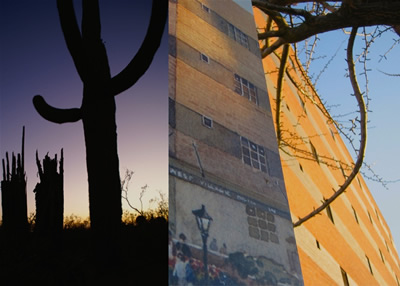It was opening night and standing room only for the premieres of Kathleen Bader’s Tentative Embrace and George Lam’s documentary opera, The Persistence of Smoke. Both Duke graduate composers had cultivated a following, beginning in 2007 with the duke new music ensemble. Setting up stages across campus, performing at Broad Street Café, and on this occasion, performing at Golden Belt (Bldg. 2), Lam believed that offering new music performances in novel venues would welcome new listeners. It worked.
Kathleen Bader’s Tentative Embrace, for 12 musicians, recorded soundscapes, and spoken text (in her own voice), transported us across the country to the Sonoran Desert. With an Interest in the interaction of visual art and music, she paints a sensual portrait of the landscape. And like James Joyce, she draws from a rich interior life, but in this case her recorded musings were focused on her experience in a habitat where she doesn’t yet belong.
It’s a work in five movements. Bader describes in her notes: “I capture its cyclical and gradual pace through slowly varying repetitions, allowing the material to unfold at its own pace.” Strings and winds are layered, revealing continuous changes in texture and hue from delicate water color to a heavy gouache. In response to the moving topography, she paints with wide swaths, but with the onset of a thunder storm, the orchestra becomes one with the environment — there are no pounding timpani. More than a single painting, Tentative Embrace is like a gallery; and more than a soundtrack or musique concrète, it is a three-dimensional composition. It’s a stunning piece.
Intermission allowed the set crew to get ready for — and the audience to switch gears to experience — The Persistence of Smoke. Conceived by composer George Lam, with a libretto by playwright John Justice, it is also connected with a place — this time a small town in the South. Justice skillfully drew from Lam’s interviews with residents in the community, and the text penetrates like a knife.
The pit orchestra, which included banjo (a nice touch) and harmonium, was compactly tucked onto stage right and conducted by the composer. Their ominous strains are brooding and dark. Repeated descending minor thirds from the piano pulsated above the rumbling texture provided by winds and strings, part of the glue that held it together so beautifully. Lam’s orchestration worked without ever creating a sense of melodrama. But the space was very live and the volume was right on the edge of becoming too loud.
The story is largely bleak, with a few sprinkles of humor for levity. The opening scene reveals a dying man with a strained relationship with his son. Daughter-in-law Skylar (Sandra Cotton, soprano), who uses a wheelchair, futilely tries to mediate. As she sings, “Oh, let him, just look at him…” with pointed clarity, Cotton conveys a nearly hopeless plea. Her compassion is lost on her spouse.
Curtis (David Weigel, bass-baritone) recalls the glory days with “Light up a Lucky…” Weigel’s deep voice was warm and resonant. He delivered the text with assurance and when called for, a wry smile. Imagining Lucy (Carolyn McDaniel) and Vinny Rey (Foreman), he remembers happiness and naiveté as they dance — cigarettes dangle from their mouths.
Nakia Verner (mezzo-soprano) sang the role of Woman, representing the African-American community, casualties of urban renewal. Except for the very demanding bottom notes, Verner’s tone was gorgeous — rich and full. Asking the loaded question, “Who gets the money?” and defiantly declaring “We’re the ones screwed,” she made me squirm in my seat.
Singing the role of the self-assured architect and son, Curtis, Scott MacLeod (baritone) delivered a stellar opening-night performance. Like a preacher singing from an elevated lectern, he captured the complexity of his role in the last aria, “What we are building is nothing new….”
Aside from a very well-crafted score and exceptionally written text, the venue was ideal and the visual aspects of the opera were well done. The Scenic Designer was Stephanie Waaser and Stage Management by provided by Dana Marks.
There was so much depth to the show! I think this is an opera with staying-power. But for residents of our city, we will be reminded of our not-so-distant history. In December, when we “Light Up Durham” and watch the illumination of the Lucky Strike tower, it may take on a whole new meaning.
The program was presented by Encounters: with the music of our time in association with The Center for Documentary Studies and the Duke University Graduate School. Ms. Bader’s piece included the Ciompi Quartet (Eric Pritchard & Hsiao-Mei Ku, violins Jonathan Bagg, viola, and Fred Raimi, cello). They were joined by the Red Clay Saxophone Quartet (Susan Fancher, soprano saxophone, Robert Faub, alto saxophone, Steven Stusek, tenor saxophone, and Mark Engebretson, baritone saxophone). Also performing were Heidi Wait, flute, Jonathan Salter, clarinet, Thom Limbert, vibraphone, and Elizabeth Tomlin, piano. The orchestra members for Mr. Lam’s piece were Jonathan Salter, clarinet, Matthew McLaughlin, horn, David Garner, banjo, Jonathan Wall, harmonium, Elizabeth Tomlin, piano, Thom Limbert, percussion, Sarah Griffin, violin, Kathleen Wilkin, viola, Elizabeth Marshall, cello, and Alex Val Gils, double bass. George Lam conducted both works.











